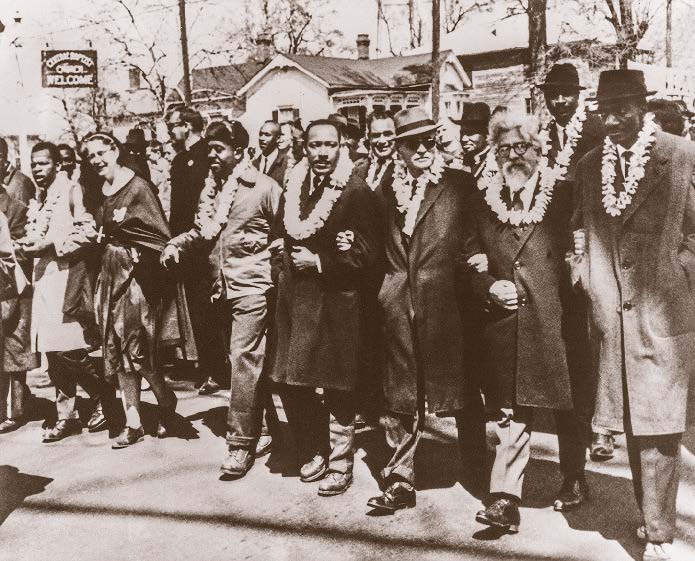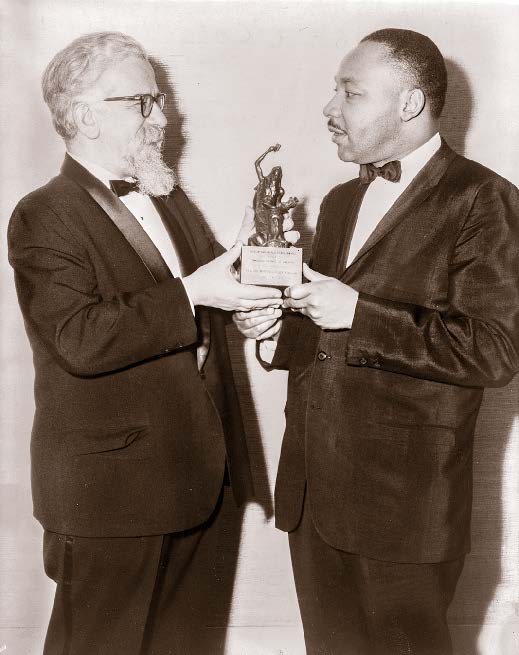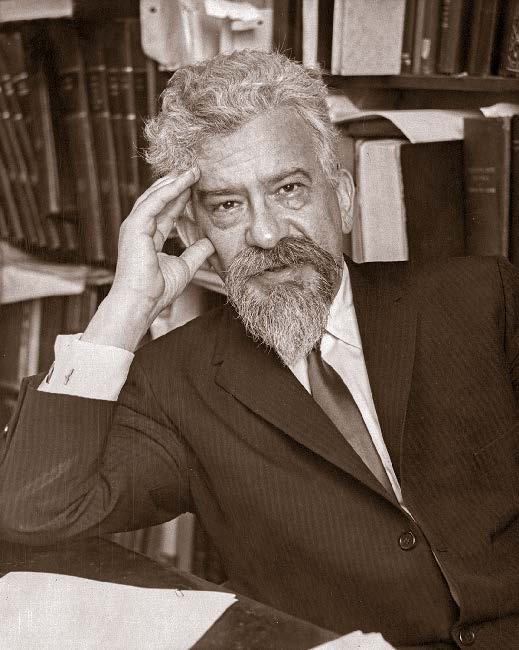
As the movement threatened to disintegrate, King sent out a call for reinforcements. One of those who answered was Rabbi Abraham Heschel, a Polish refugee, Holocaust survivor, and New York seminary professor. Already, Heschel had led a group of more than eight hundred people to the FBI headquarters in Manhattan, demanding federal protection for the marchers in Selma. King was grateful to Heschel for that, just as he was grateful to all the clergy who answered his summons to Selma. Their presence affirmed the moral gravity of the cause, and no one embodied that gravity more than Heschel.
King had long admired Heschel, ever since reading his book, The Prophets (Harper & Row, 1962), which was about voices of justice from an ancient time. “The prophet is a man who feels fiercely,” Heschel had written. “God has thrust a burden upon his soul, and he is bowed and stunned by man’s fierce greed…. God is raging in the prophet’s words.”
King thought he saw some of that raging in Heschel, tempered, perhaps, by a gentle disposition and twinkling sense of humor. But there was a gravitas—a theological grounding— that King understood and turned to now in a difficult time. On March 21, when, for a third time, civil rights demonstrators set out to march from Selma to Montgomery, protected this time by a federal court order against state interference, King asked Heschel to walk beside him. An iconic photograph resulted: King with Ralph Abernathy on his right and Ralph Bunche and Heschel on his left.
For many years, a journalist in Selma often heard the story —apocryphal, perhaps, for it was difficult to track down—of a little African American boy standing with his mother on the side of the road, as the line of protesters approached.
“Look, Mama,” said the little boy, pointing at Heschel, “I think it’s God.”
The friendship between King and Heschel began on January 14, 1963, when both were speaking at the National Conference on Religion and Race held in Chicago, Illinois. In his address Heschel began with what seemed at first to be a touch of humor, but his words quickly turned serious: “At the first conference on religion and race, the main participants were Pharaoh and Moses…. The outcome of that summit meeting has not come to an end. Pharaoh is not ready to capitulate. The exodus began but is far from having been completed. In fact, it was easier for the children of Israel to cross the Red Sea than for a Negro to cross certain university campuses.” Leaning into his subject, Heschel argued that the mere concept of race was an invitation to the evil of racism, which he regarded as “man’s gravest threat to man.”
“Religion and race,” he asked rhetorically, “how can the two be uttered together? To act in the spirit of religion is to unite what lies apart, to remember that humanity as a whole is God’s beloved child. To act in the spirit of race is to sunder, to slash, to dismember the flesh of living humanity. Is this the way to honor a father: to torture his child?”
Heschel could not have been surprised that his words resonated with King. There was an urgency about the rabbi’s message that King certainly shared. But more than that, their similar understanding of biblical history was apparent from the start. Ever since the Montgomery Bus Boycott, King had used the analogy of Exodus—the Old Testament story of Pharaoh and Moses—and the struggle of the Jewish people to be free. And in the summer of 1963, seven months after their meeting in Chicago, he delivered his “I Have a Dream” speech in Washington, DC, quoting from the prophet Amos: “No, we…will not be satisfied until justice rolls down like waters and righteousness like a mighty stream.”
As it happened, this was one of Heschel’s favorite verses. He had written about Amos in the first chapter of The Prophets, casting him as a man who regarded injustice as a “catastrophe.” Amos raved, wrote Heschel, “as if the whole world were a slum,” but there was a flipside to the prophet’s wrath—God’s wrath—at the cruelty and suffering he saw in the world. There was always hope—always God’s inexplicable promise of nobler possibilities to come.
Three months after the March on Washington, King and Heschel met again, this time at the United Synagogue of America Golden Jubilee Convention, where King spoke against the oppression of “my brothers and sisters who happen to be Jews in Soviet Russia.” As the friendship between the two men deepened, they began to explore an affinity more subtle than the politics of faith—the passionate demand for social justice that initially brought them together. The roots of that concern, they were starting to see, began with a common understanding of God.
The rabbi’s daughter, Susannah Heschel, chair of Jewish Studies at Dartmouth College, wrote that her father and King shared “a fundamental assumption of divine concern with the events that are transpiring in the Civil Rights struggle. God is involved and engaged in that struggle, because God is not remote and transcendent, but…is affected by the treatment human beings accord one another,…suffering with us.” Neither man came to that conclusion easily. The history of Jews, like the history of African Americans, was riddled with pain—a fact they both understood intellectually, as well as personally. They knew it was fair to ask why a benevolent God would permit it. Why would he allow his people to suffer? For Heschel and King, the journey to an answer involved personal moments of anguish.
Heschel narrowly survived the Holocaust. He was born in Warsaw in 1907, the son of a rabbi whose congregation consisted primarily of impoverished Jews. Raised amid the piety of his Hasidic family, he soon sought to broaden his view of the world. As a teenager, he published a volume of Yiddish poetry, then studied in Berlin, regarded at the time as the intellectual capital of Europe. He pursued his doctorate at the University of Berlin, where he wrote a dissertation he later expanded into his book, The Prophets.
These were terrible times in Europe, and Heschel would soon see suffering on a scale that he had simply never imagined. He witnessed Hitler’s accession of power on January 30, 1933, followed soon after by the Reichstag fire and the infamous book burning at the University of Berlin. He continued to write and lecture in Germany until October 1938, when he and other Polish Jews were expelled. Susannah Heschel wrote:
Suddenly, in the middle of the night, the Gestapo arrived and gave him one hour to pack two suitcases. He quickly gathered his manuscripts and books and then carried two very heavy suitcases through the streets of Frankfurt to police headquarters, where he was held overnight in a tiny cell. The next morning he was put on a train packed with deported Jews. He told me he had to stand for the duration of a three-day journey to Poland. Denied entry into Poland, the Jews were held at the border in miserable conditions, many remaining for months. The local Poles refused to give the Jews food. My father was fortunate: his family soon secured his release, and he joined them in Warsaw.
Eisen was nineteen years old, a student journalist at the University of Pennsylvania, when he and Heschel met. He came to the rabbi’s study in New York, having summoned the courage to ask for an interview, and found himself “surrounded by books, floor-to-ceiling books, with barely enough room to stand or sit, with this figure with a long white beard, looking very prophetic, but with kind and twinkling eyes.”
The two of them talked about hard things, including the Holocaust, and Heschel told him, “You have doubts [about God]. I do too.” But somewhere on the other side of his doubts and his anguish, the rabbi made his great leap of faith. In his book Israel: An Echo of Eternity (Farrar, Straus and Giroux, 1969), Heschel wrote: “Our people’s faith in God at this moment in history did not falter. At this moment in history Isaac was indeed sacrificed, his blood shed. We all died in Auschwitz, yet our faith survived. We knew that to repudiate God would be to continue the Holocaust.”
King, as Heschel would learn, had embarked on a similar journey of faith. As a student of theology at Boston University and Crozer Theological Seminary, King had written skeptically of philosophers from Aristotle to Paul Tillich (whose conceptions of God were, he thought, grand but ultimately “devoid of consciousness and life”). As his biographer Lewis Baldwin has noted, King was a product of the African American church, whose belief in a personal God grew stronger during the early years of the civil rights movement.
King himself remembered a moment in 1956 when the God of history in whom he believed—the God who embraced the cause of justice, even in the midst of human suffering— suddenly and quietly became more real. On January 26, during the early weeks of the Montgomery Bus Boycott, King was arrested and thrust into the back of a police car. He noticed, to his horror, that the cruiser was headed straight out of town. As they crossed the muddy waters of the Alabama River, he could imagine himself floating face down, a police bullet lodged in his brain. Such things happened to black men in the South. He was trembling badly, and he was embarrassed by his fear, when the police car finally turned around and took him to the jail. This time they only meant to scare him.
King was barely twenty-seven years old, and as he sat alone on the following night, brewing a pot of coffee in his kitchen, he worried that maybe he was out of his depth. The telephone rang. It was a white man threatening his life. King hung up the phone. He could feel a prayer taking shape in his mind, not really a plea for divine intervention, just some words of desperation he could not suppress: “Lord, I must confess that I’m weak now. I’m faltering. I’m losing my courage. And I can’t let the people see me like this.”
For King it was a moment of truth, and nine years later, when he and Heschel arrived in Selma, they shared an assumption of divine concern—a faith in which a personal communion between God and man often took unexpected forms. After the march, Heschel wrote a letter to King affirming his view that the protest was holy—“a day of sanctification,” he said, in which men and women were doing the work of God. This understanding became the heart of their friendship—faith in a God who was not an omnipotent puppeteer, pulling the strings of human history, but one who shared in the suffering of the world and needed, even demanded, the help of human beings to heal it.
It was a view with implications beyond civil rights. Even as they celebrated the Selma triumph and the subsequent passage of the Voting Rights Act of 1965, Heschel and King worried about the war in Vietnam. Heschel was the first to take a public stand, and he quietly urged King to do the same. From the earliest months of escalation, the rabbi was tormented by the war. “How can I pray,” he asked rhetorically, “when I have on my conscience the awareness that I am co-responsible for the death of innocent people in Vietnam? In a free society, some are guilty, all are responsible.”
“My father was sleepless over Vietnam,” Susannah Heschel explained. “He would be up late at night—one, two, three in the morning—couldn’t sleep he was so upset. It was on his mind all the time.”
In October 1965 Heschel joined John C. Bennett, president of Union Theological Seminary, in organizing a meeting of one hundred clergy in New York to form an organization called Clergy and Laymen Concerned about Vietnam. King was present at the meeting as well, even though the war posed a difficult political problem for him. With the passage of the Civil Rights Act of 1964 and the Voting Rights Act the following year, Pres. Lyndon Johnson had emerged as a friend to the civil rights movement, and many of King’s most trusted advisers urged him not to break with the president over Vietnam.
For much of 1966, King agonized about the issue. But in January 1967, he opened a copy of Ramparts Magazine, a left-leaning monthly, and saw pictures of Vietnamese children gravely wounded by American napalm. He decided he could keep silent no longer. He talked to Heschel about the possibility of a major speech on the war, sponsored by Clergy and Laymen Concerned about Vietnam, which had become well-established as a non-violent antiwar organization. Heschel and other leaders of the group suggested that he speak at Riverside Church. King was delighted by that idea. There was, he thought, no more majestic cathedral in the country than Riverside, which towered over the Hudson River in upper Manhattan. On April 4, 1967, King ascended the pulpit beneath the great stone arches to deliver the most controversial speech of his career. Heschel stood at his side. Heschel, as he introduced King, said:
Our thoughts on Vietnam are sores, destroying our trust, ruining our most cherished commitments with burdens of shame. We are pierced to the core with pain, and it is our duty as citizens to say no to the subversiveness of our government.... We are here because our own integrity as human beings is decaying in the agony and merciless killing done in our name.
As I ponder the madness of Vietnam my mind goes constantly to the people of that peninsula…. They watch as we poison their water, as we kill a million acres of their crops. They must weep as the bulldozers roar through their areas preparing to destroy the precious trees. They wander into the hospitals, with at least twenty casualties from American firepower for one ‘Viet Cong’-inflicted injury. So far we may have killed a million of them—mostly children
Heschel’s support for King never wavered. “Where in America today” he asked, “do we hear a voice like the voice of the prophets of Israel? Martin Luther King is a sign that God has not forsaken the United States of America. God has sent him to us. His presence is the hope of America.”
The year 1968 found King traveling the back roads of Alabama and other parts of the South, trying to build support for a Poor People’s March on Washington. In his private moments, he was depressed. The war raged on in Vietnam, and despite the gains of the civil rights movement, he sensed the racial divide in America growing deeper. “I am sorry to have to say,” he had concluded, “that the majority of white Americans are racist.” He was also focused on the issue of poverty and the staggering level of income inequality in the richest country on earth.
In these days, he found some solace in his time with Heschel. On March 25, he spoke at a birthday celebration for the rabbi, convened by the Rabbinical Assembly of America, and affirmed that Heschel “is, indeed, a truly great prophet.” Heschel, in response, invited King and his wife to participate in a family Passover Seder, scheduled for April 16. “The ritual and the celebration of that evening seek to make present to us the spirit and the wonder of the exodus from Egypt,” Heschel wrote. “It is my feeling that your participation at a Seder celebration would be of very great significance.”
King never made it to the Seder. On April 3 in Memphis, Tennessee, speaking in support of a strike by sanitation workers, and reaching deep for the faith to overcome his depression, King evoked the spirit of Exodus, declaring that he had “seen the Promised Land.” He compared the civil rights movement to the burning bush from which God spoke to Moses: “Bull Connor next would say, ‘Turn the firehoses on….’ Bull Connor didn’t know history. He knew a kind of physics that somehow didn’t relate to the trans-physics that we knew about, and that was the fact there was a certain kind of fire that no water could put out.”
The following day King was murdered on his motel balcony, and Rabbi Heschel rushed to Atlanta to speak at the funeral of his friend. In his grief he reaffirmed things he had already said about King’s divinely inspired life.
In the years since then, Susannah Heschel has written frequently about the friendship between her father and King, an intimacy that was rooted in faith, a prophet’s agony in a sinful world, where the arc of the moral universe was long, and God’s justice always loomed just out of reach.
This article was previously published in Alabama Heritage Issue 136, Spring 2020.
Author
Frye Gaillard, writer in residence at the University of South Alabama, is the author of such award-winning books as Cradle of Freedom: Alabama and the Movement That Changed America (University of Alabama Press, 2006); A Hard Rain: America in the 1960s (NewSouth Books, 2016); and Go South to Freedom (NewSouth Books, 2016). His most recent publication is a book for young readers, The Slave Who Went to Congress (NewSouth Books, 2020), co-authored with Marti Rosner. Gaillard has been the recipient of the Lillian Smith Book Award, the Clarence Cason Award, and the Alabama Governor’s Award for the Arts.


 RSS Feed
RSS Feed